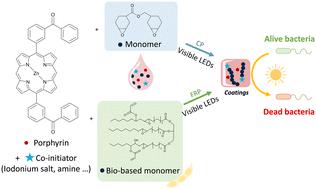当前位置:
X-MOL 学术
›
Polym. Chem.
›
论文详情
Our official English website, www.x-mol.net, welcomes your feedback! (Note: you will need to create a separate account there.)
Porphyrin-based photosensitizers for visible-light polymerization and antibacterial applications
Polymer Chemistry ( IF 4.6 ) Pub Date : 2024-03-01 , DOI: 10.1039/d4py00126e Fanny Schnetz 1 , Iryna Knysh 2 , Denis Jacquemin 2, 3 , Samir Abbad Andaloussi 4 , Marc Presset 1 , Sonia Lajnef 5 , Fabienne Peyrot 5, 6 , Davy-Louis Versace 1
Polymer Chemistry ( IF 4.6 ) Pub Date : 2024-03-01 , DOI: 10.1039/d4py00126e Fanny Schnetz 1 , Iryna Knysh 2 , Denis Jacquemin 2, 3 , Samir Abbad Andaloussi 4 , Marc Presset 1 , Sonia Lajnef 5 , Fabienne Peyrot 5, 6 , Davy-Louis Versace 1
Affiliation

|
This study highlights the outstanding photo-initiating properties of two new visible-light absorbing benzophenone porphyrin-based photosensitizers (PBP and PBPZn) for the free-radical (FRP), cationic (CP) photopolymerization and thiol–ene reactions under visible LEDs exposure (405, 505 and 530 nm) under air or in laminate, and at low intensities. As confirmed by electronic paramagnetic resonance spin trapping (EPR ST) and Laser Flash Photolysis studies, both porphyrins play a dual role as electron donor molecule when combined with iodonium salt (Iod) and participate in a H-abstraction reaction in association with N-methyldiethanol amine (MDEA) or thiol derivatives (cysteamine or N-acetylcysteine). For the first time, interesting kinetic profiles for the polymerization of a bio-based monomer (SOA) are observed under blue and green-light irradiation. Notably, the 4-methylphenyl-, aminoalkyl- and thiyl radicals which are generated from the photolysis of porphyrin/Iod, porphyrin/MDEA and porphyrin/cysteamine (or N-acetylcysteine) respectively, can initiate the radical polymerization of SOA and very high FCs are observed; up to 90% under LED@405 nm and >60% under LED@530 nm exposure. Finally, PBPZn-based materials demonstrated photoactivable properties for antibacterial applications. Under visible-light irradiation, these materials can produce biocide reactive oxygen species (ROS) leading to a tremendous inhibition of S. aureus proliferation.
中文翻译:

用于可见光聚合和抗菌应用的卟啉基光敏剂
这项研究强调了两种新型可见光吸收二苯甲酮卟啉基光敏剂(PBP和PBPZn)在可见光 LED 曝光下的自由基(FRP)、阳离子(CP)光聚合和硫醇-烯反应中具有出色的光引发性能( 405、505 和 530 nm)在空气中或在层压板中,并且在低强度下。电子顺磁共振自旋捕获 (EPR ST) 和激光闪光光解研究证实,两种卟啉在与碘鎓盐 (Iod) 结合时发挥电子供体分子的双重作用,并参与与 N-甲基二乙醇相关的 H抽象反应胺(MDEA)或硫醇衍生物(半胱胺或N-乙酰半胱氨酸)。首次在蓝光和绿光照射下观察到生物基单体(SOA)聚合的有趣动力学曲线。值得注意的是,分别由卟啉/碘、卟啉/MDEA和卟啉/半胱胺(或N-乙酰半胱氨酸)光解产生的4-甲基苯基-、氨烷基-和硫基自由基,可以引发SOA和非常高的FC的自由基聚合被观察到;在 LED@405 nm 曝光下高达 90%,在 LED@530 nm 曝光下高达 60%。最后,PBPZn基材料展示了用于抗菌应用的光敏特性。在可见光照射下,这些材料可以产生杀菌剂活性氧(ROS),从而极大地抑制金黄色葡萄球菌的增殖。
更新日期:2024-03-06
中文翻译:

用于可见光聚合和抗菌应用的卟啉基光敏剂
这项研究强调了两种新型可见光吸收二苯甲酮卟啉基光敏剂(PBP和PBPZn)在可见光 LED 曝光下的自由基(FRP)、阳离子(CP)光聚合和硫醇-烯反应中具有出色的光引发性能( 405、505 和 530 nm)在空气中或在层压板中,并且在低强度下。电子顺磁共振自旋捕获 (EPR ST) 和激光闪光光解研究证实,两种卟啉在与碘鎓盐 (Iod) 结合时发挥电子供体分子的双重作用,并参与与 N-甲基二乙醇相关的 H抽象反应胺(MDEA)或硫醇衍生物(半胱胺或N-乙酰半胱氨酸)。首次在蓝光和绿光照射下观察到生物基单体(SOA)聚合的有趣动力学曲线。值得注意的是,分别由卟啉/碘、卟啉/MDEA和卟啉/半胱胺(或N-乙酰半胱氨酸)光解产生的4-甲基苯基-、氨烷基-和硫基自由基,可以引发SOA和非常高的FC的自由基聚合被观察到;在 LED@405 nm 曝光下高达 90%,在 LED@530 nm 曝光下高达 60%。最后,PBPZn基材料展示了用于抗菌应用的光敏特性。在可见光照射下,这些材料可以产生杀菌剂活性氧(ROS),从而极大地抑制金黄色葡萄球菌的增殖。



























 京公网安备 11010802027423号
京公网安备 11010802027423号